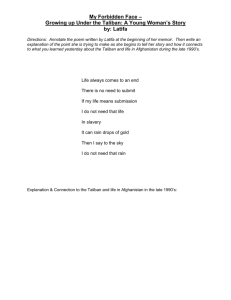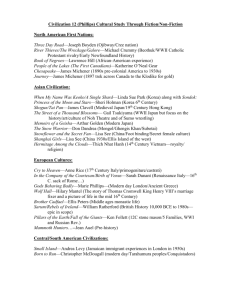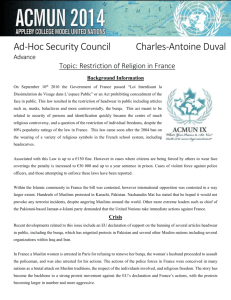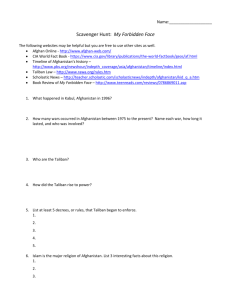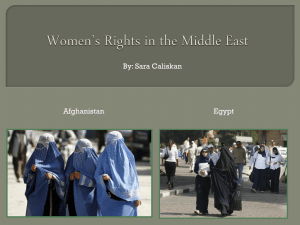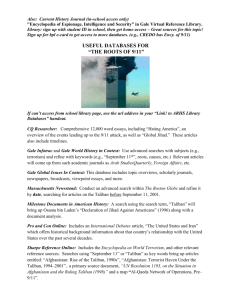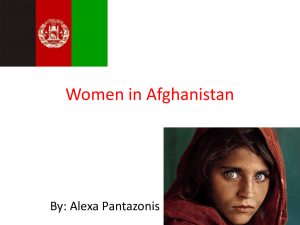Do Muslim Women Really Need Saving? Anthropological
advertisement
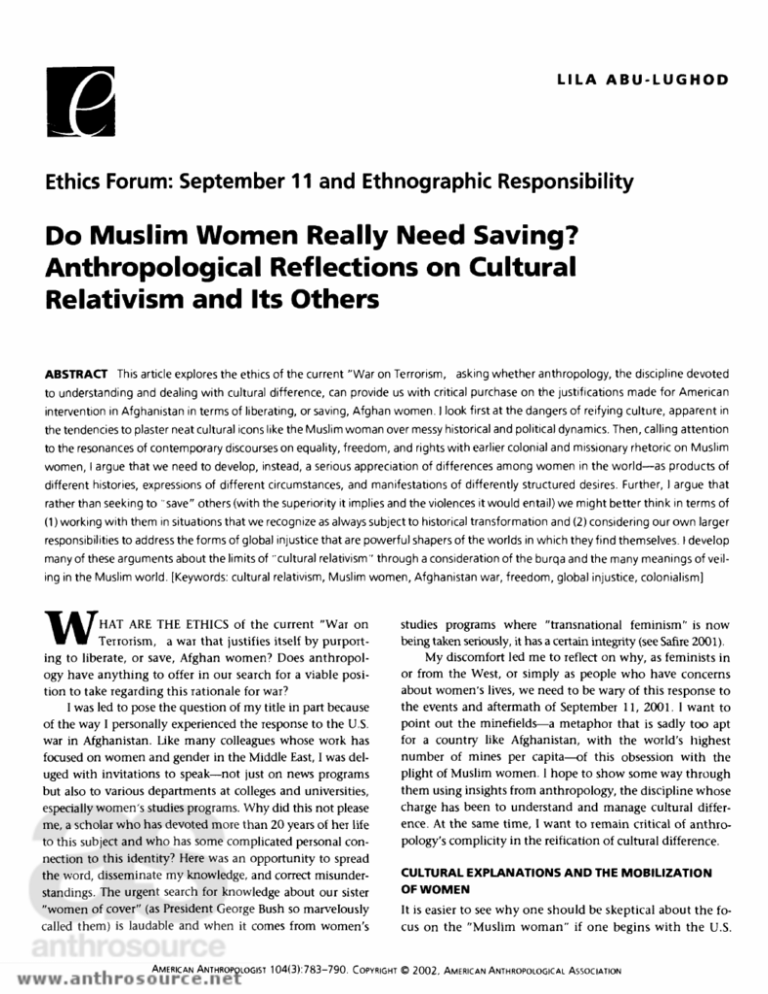
LILA ABU-LUGHOD Ethics Forum: September 11 and Ethnographic Responsibility Do Muslim Women Really Need Saving? Anthropological Reflections on Cultural Relativism and Its Others ABSTRACT This article explores the ethics of the current "War on Terrorism, asking whether anthropology, the discipline devoted to understanding and dealing with cultural difference, can provide us with critical purchase on the justifications made for American intervention in Afghanistan in terms of liberating, or saving, Afghan women. I look first at the dangers of reifying culture, apparent in the tendencies to plaster neat cultural icons like the Muslim woman over messy historical and political dynamics. Then, calling attention to the resonances of contemporary discourses on equality, freedom, and rights with earlier colonial and missionary rhetoric on Muslim women, I argue that we need to develop, instead, a serious appreciation of differences among women in the world—as products of different histories, expressions of different circumstances, and manifestations of differently structured desires. Further, I argue that rather than seeking to "save" others (with the superiority it implies and the violences it would entail) we might better think in terms of (1) working with them in situations that we recognize as always subject to historical transformation and (2) considering our own larger responsibilities to address the forms of global injustice that are powerful shapers of the worlds in which they find themselves. I develop many of these arguments about the limits of "cultural relativism" through a consideration of the burqa and the many meanings of veiling in the Muslim world. [Keywords: cultural relativism, Muslim women, Afghanistan war, freedom, global injustice, colonialism] W HAT ARE THE ETHICS of the current "Wai on Terrorism, a war that justifies itself by purporting to liberate, or save, Afghan women? Does anthropology have anything to offer in our search for a viable position to take regarding this rationale for war? I was led to pose the question of my title in part because of the way I personally experienced the response to the U,S, war in Afghanistan. Like many colleagues whose work has focused on women and gender in the Middle East, I was deluged with invitations to speak—not just on news programs but also to various departments at colleges and universities, especially women's studies programs. Why did this not please me, a scholar who has devoted more than 20 years of her life to this subject and who has some complicated personal connection to this identity? Here was an opportunity to spread the word, disseminate my knowledge, and correct misunderstandings. The urgent search for knowledge about our sister "women of cover" (as President George Bush so marvelously called them) is laudable and when it comes from women's studies programs where "transnational feminism" is now being taken seriously, it has a certain integrity (see Safire 2001), My discomfort led me to reflect on why, as feminists in or from the West, or simply as people who have concerns about women's lives, we need to be wary of this response to the events and aftermath of September 11, 2001, 1 want to point out the minefields—a metaphor that is sadly too apt for a country like Afghanistan, with the world's highest number of mines per capita—of this obsession with the plight of Muslim women, 1 hope to show some way through them using insights from anthropology, the discipline whose charge has been to understand and manage cultural difference, At the same time, I want to remain critical of anthropology's complicity in the reification of cultural difference, CULTURAL EXPLANATIONS AND THE MOBILIZATION OF WOMEN It is easier to see why one should be skeptical about the focus on the "Muslim woman" if one begins with the U.S. AMERICAN ANTHROPOLOGIST 1 0 4 ( 3 ) : 7 8 3 - 7 9 0 . COPYRIGHT © 2 0 0 2 . AMERICAN ANTHROPOLOGICAL ASSOCIATION 784 American Anthropologist Vol. 104, No. 3 • September 2002 public response. I will analyze two manifestations of this response: some conversations I had with a reporter from the PBS NewsHour with Jim Lehrer and First Lady Laura Bush's radio address to the nation on November 17, 2001, The presenter from the NewsHour show first contacted me in October to see if I was willing to give some background for a segment on Women and Islam, I mischievously asked whether she had done segments on the women of Guatemala, Ireland, Palestine, or Bosnia when the show covered wars in those regions; but I finally agreed to look at the questions she was going to pose to panelists, The questions were hopelessly general. Do Muslim women believe "x"? Are Muslim women "y"? Does Islam allow "z" for women? 1 asked her: If you were to substitute Christian or Jewish wherever you have Muslim, would these questions make sense? I did not imagine she would call me back, But she did, twice, once with an idea for a segment on the meaning of Ramadan and another time on Muslim women in politics. One was in response to the bombing and the other to the speeches by Laura Bush and Cherie Blair, wife of the British Prime Minister. What is striking about these three ideas for news programs is that there was a consistent resort to the cultural, as if knowing something about women and Islam or the meaning of a religious ritual would help one understand the tragic attack on New York's World Trade Center and the U.S. Pentagon, or how Afghanistan had come to be ruled by the Taliban, or what interests might have fueled US, and other interventions in the region over the past 25 years, or what the history of American support for conservative groups funded to undermine the Soviets might have been, or why the caves and bunkers out of which Bin Laden was to be smoked "dead or alive, as President Bush announced on television, were paid for and built by the CIA, In other words, the question is why knowing about the "culture" of the region, and particularly its religious beliefs and treatment of women, was more urgent than exploring the history of the development of repressive regimes in the region and the U.S. role in this history, Such cultural framing, it seemed to me, prevented the serious exploration of the roots and nature of human suffering in this part of the world, Instead of political and historical explanations, experts were being asked to give religiocultural ones, Instead of questions that might lead to the exploration of global interconnections, we were offered ones that worked to artificially divide the world into separate spheres—recreating an imaginative geography of West versus East, us versus Muslims, cultures in which First Ladies give speeches versus others where women shuffle around silently in burqas, Most pressing for me was why the Muslim woman in general, and the Afghan woman in particular, were so crucial to this cultural mode of explanation, which ignored the complex entanglements in which we are all implicated, in sometimes surprising alignments, Why were these female symbols being mobilized in this "War against Terror- ism" in a way they were not in other conflicts? Laura Bush's radio address on November 17 reveals the political work such mobilization accomplishes, On the one hand, her address collapsed important distinctions that should have been maintained, There was a constant slippage between the Taliban and the terrorists, so that they became almost one word—a kind of hyphenated monster identity: the Taliban-and-the-terrorists. Then there was the blurring of the very separate causes in Afghanistan of women's continuing malnutrition, poverty, and ill health, and their more recent exclusion under the Taliban from employment, schooling, and the joys of wearing nail polish, On the other hand, her speech reinforced chasmic divides, primarily between the "civilized people throughout the world" whose hearts break for the women and children of Afghanistan and the Taliban-and-the-terrorists, the cultural monsters who want to, as she put it, "impose their world on the rest of us," Most revealingly, the speech enlisted women to justify American bombing and intervention in Afghanistan and to make a case for the "War on Terrorism" of which it was allegedly a part, As Laura Bush said, "Because of our recent military gains in much of Afghanistan, women are no longer imprisoned in their homes, They can listen to music and teach their daughters without fear of punishment, The fight against terrorism is also a fight for the rights and dignity of women" (U.S. Government 2002), These words have haunting resonances for anyone who has studied colonial history, Many who have worked on British colonialism in South Asia have noted the use of the woman question in colonial policies where intervention into sati (the practice of widows immolating themselves on their husbands' funeral pyres), child marriage, and other practices was used to justify rule, As Gayatri Chakravorty Spivak (1988) has cynically put it: white men saving brown women from brown men, The historical record is full of similar cases, including in the Middle East, In Turn of the Century Egypt, what Leila Ahmed (1992) has called "colonial feminism" was hard at work, This was a selective concern about the plight of Egyptian women that focused on the veil as a sign of oppression but gave no support to women's education and was professed loudly by the same Englishman, Lord Cromer, who opposed women's suffrage back home. Sociologist Marnia Lazreg (1994) has offered some vivid examples of how French colonialism enlisted women to its cause in Algeria, She writes: Perhaps the most spectacular example of the colonial appropriation of women's voices, and the silencing of those among them who had begun to take women revolutionaries . . . as role models by not donning the veil, was the event of May 16, 1958 [just four years before Algeria finally gained its independence from France after a long bloody struggle and 130 years of French control—L,A.], On that day a demonstration was organized by rebellious French generals in Algiers to show their determination to keep Algeria French, To give the government of France evidence that Algerians were in agreement with them, the Abu-Lughod • Do Muslim Women Really Need Saving? generals had a few thousand native men bused in from nearby villages, along with a few women who were solemnly unveiled by French women. .. Rounding up Algerians and bringing them to demonstrations of loyalty to France was not in itself an unusual act during the colonial era, But to unveil women at a well-choreographed ceremony added to the event a symbolic dimension that dramatized the one constant feature of the Algerian occupation by France: its obsession with women. [Lazreg 1994:135] Lazreg (1994) also gives memorable examples of the way in which the French had earlier sought to transform Arab women and girls, She describes skits at awards ceremonies at the Muslim Girls' School in Algiers in 1851 and 1852, In the fust skit, wiitten by "a Fiench lady from Algieis,' two Algerian Arab girls Teminisced about theiT trip to France with woids including the following: Oh! Protective France: Oh! Hospitable France!. .. Noble land, where I felt free Under Christian skies to pray to our God:.. , God bless you for the happiness you bring us! And you, adoptive mother, who taught us That we have a share of this world, We will cherish you forever! [Lazreg 1994:68-69] These girls are made to invoke the gift of a share of this world, a world where freedom reigns under Christian skies. This is not the woild the Taliban-and-the-tenorists would "like to impose on the Test of us,' Just as I aigued above that we need to be suspicious when neat cultural icons aie plastered over messier historical and political nanatives, so we need to be wary when Loid Ciomei in Biitish-iuled Egypt, Fiench ladies in Algeria, and LauTa Bush, all with military tioops behind them, claim to be saving or liberating Muslim women, POLITICS OF THE VEIL I want now to look rnoie closely at those Afghan women Lama Bush claimed were 'rejoicing" at theiT liberation by the Americans, This necessitates a discussion of the veil, OT the bUTqa, because it is so central to contemporary concerns about Muslim women, This will set the stage for a discussion of how anthropologists, feminist anthropologists in particular, contend with the problem of difference in a global world. In the conclusion, I will return to the rhetoric of saving Muslim women and offer an alternative, It is common popular knowledge that the ultimate sign of the oppression of Afghan women under the Taliban-and-the-terrorists is that they were forced to wear the burqa. Liberals sometimes confess their surprise that even though Afghanistan has been liberated from the Taliban, women do not seem to be throwing off their burqas. Someone who has worked in Muslim regions must ask why this is so surprising, Did we expect that once "free" from the Taliban they would go "back" to belly shirts and blue jeans, or dust off their Chanel suits? We need to be more sensible about the clothing of "women of cover, and so there is perhaps a need to make some basic points about veiling, 785 First, it should be recalled that the Taliban did not invent the burqa, It was the local form of covering that Pashtun women in one region wore when they went out, The Pashtun are one of several ethnic groups in Afghanistan and the burqa was one of many forms of covering in the subcontinent and Southwest Asia that has developed as a convention for symbolizing women's modesty or respectability. The burqa, like some other forms of "cover" has, in many settings, marked the symbolic separation of men's and women's spheres, as part of the general association of women with family and home, not with public space where strangers mingled. Twenty years ago the anthropologist Hanna Papanek (1982), who worked in Pakistan, described the burqa as "portable seclusion.' She noted that many saw it as a liberating invention because it enabled women to move out of segregated living spaces while still observing the basic moral requirements of separating and protecting women from unrelated men. Ever since I came across her phrase portable seclusion, I have thought of these enveloping robes as "mobile homes," Everywhere, such veiling signifies belonging to a particular community and participating in a moral way of life in which families are paramount in the organization of communities and the home is associated with the sanctity of women. The obvious question that follows is this: If this were the case, why would women suddenly become immodest? Why would they suddenly throw off the markers of their respectability, markers, whether burqas or other forms of cover, which were supposed to assure their protection in the public sphere from the harassment of strange men by symbolically signaling to all that they were still in the inviolable space of their homes, even though moving in the public realm? Especially when these are forms of dress that had become so conventional that most women gave little thought to their meaning, To draw some analogies, none of them perfect, why are we surprised that Afghan women do not throw off their burqas when we know perfectly well that it would not be appropriate to wear shorts to the opera? At the time these discussions of Afghan women's burqas were raging, a friend of mine was chided by her husband for suggesting she wanted to wear a pantsuit to a fancy wedding; "You know you don't wear pants to a WASP wedding,' he reminded her. New Yorkers know that the beautifully coiffed Hasidic women, who look so fashionable next to their dour husbands in black coats and hats, are wearing wigs, This is because religious belief and community standards of propriety require the covering of the hair, They also alter boutique fashions to include high necks and long sleeves, As anthropologists know perfectly well, people wear the appropriate form of dress for their social communities and are guided by socially shared standards, religious beliefs, and moral ideals, unless they deliberately transgress to make a point or are unable to afford proper cover. If we think that U.S. women live in a world of 786 American Anthropologist • Vol. 104, No, 3 • September 2002 choice regarding clothing, all we need to do is remind ourselves of the expression, "the tyranny of fashion,' What had happened in Afghanistan under the Taliban is that one regional style of covering OT veiling, associated with a certain Tespectable but not elite class, was imposed on everyone as "religiously" appropriate, even though previously there had been many different styles, popular or traditional with different groups and classes—different ways to mark women's propriety, or, in more recent times, religious piety. Although I am not an expert on Afghanistan, I imagine that the majority of women left in Afghanistan by the time the Taliban took control were the rural or less educated, from nonelite families, since they were the only ones who could not emigrate to escape the hardship and violence that has marked Afghanistan's recent history, If liberated from the enforced wearing of burqas, most of these women would choose some other form of modest headcovering, like all those living nearby who were not under the Taliban—their rural Hindu counterparts in the North of India (who cover their heads and veil their faces from affines) or their Muslim sisters in Pakistan, Even The New York Times carried an article about Afghan women refugees in Pakistan that attempted to educate readers about this local variety (Fremson 2001), The article describes and pictures everything from the nowiconic burqa with the embroidered eyeholes, which a Pashtun woman explains is the proper dress for her community, to large scarves they call chadors, to the new Islamic modest dress that wearers refer to as hijab, Those in the new Islamic dress are characteristically students heading for professional careers, especially in medicine, just like their counterparts from Egypt to Malaysia, One wearing the large scarf was a school principal; the other was a poor street vendor, The telling quote from the young street vendor is, "If I did [wear the burqa] the refugees would tease me because the burqa is for 'good women' who stay inside the home" (Fremson 2001:14), Here you can see the local status associated with the burqa—it is for good respectable women from strong families who are not forced to make a living selling on the street. The British newspaper The Guardian published an interview in January 2002 with Dr, Suheila Siddiqi, a respected surgeon in Afghanistan who holds the rank of lieutenant general in the Afghan medical corps (Goldenberg 2002), A woman in her sixties, she comes from an elite family and, like her sisters, was educated. Unlike most women of her class, she chose not to go into exile, She is presented in the article as "the woman who stood up to the Taliban" because she refused to wear the burqa. She had made it a condition of returning to her post as head of a major hospital when the Taliban came begging in 1996, just eight months after firing her along with other women, Siddiqi is described as thin, glamorous, and confident, But further into the article it is noted that her graying bouffant hair is covered in a gauzy veil, This is a reminder that though she refused the burqa, she had no question about wearing the chador or scarf. Finally, I need to make a crucial point about veiling, Not only are there many forms of covering, which themselves have different meanings in the communities in which they are used, but also veiling itself must not be confused with, or made to stand for, lack of agency. As I have argued in my ethnography of a Bedouin community in Egypt in the late 1970s and 1980s (1986), pulling the black head cloth over the face in front of older respected men is considered a voluntary act by women who are deeply committed to being moral and have a sense of honor tied to family. One of the ways they show their standing is by covering their faces in certain contexts, They decide for whom they feel it is appropriate to veil, To take a very different case, the modern Islamic modest dress that many educated women across the Muslim world have taken on since the mid-1970s now both publicly marks piety and can be read as a sign of educated urban sophistication, a sort of modernity (e.g., Abu-Lughod 1995, 1998; Brenner 1996; El Guindi 1999; MacLeod 1991; Ong 1990), As Saba Mahmood (2001) has so brilliantly shown in her ethnography of women in the mosque movement in Egypt, this new form of dress is also perceived by many of the women who adopt it as part of a bodily means to cultivate virtue, the outcome of their professed desire to be close to God, Two points emerge from this fairly basic discussion of the meanings of veiling in the contemporary Muslim world, First, we need to work against the reductive interpretation of veiling as the quintessential sign of women's unfreedom, even if we object to state imposition of this form, as in Iran or with the Taliban, (It must be recalled that the modernizing states of Turkey and Iran had earlier in the century banned veiling and required men, except religious clerics, to adopt Western dress.) What does freedom mean if we accept the fundamental premise that humans are social beings, always raised in certain social and historical contexts and belonging to particular communities that shape their desires and understandings of the world? Is it not a gross violation of women's own understandings of what they are doing to simply denounce the burqa as a medieval imposition? Second, we must take care not to reduce the diverse situations and attitudes of millions of Muslim women to a single item of clothing, Perhaps it is time to give up the Western obsession with the veil and focus on some serious issues with which feminists and others should indeed be concerned, Ultimately, the significant political-ethical problem the burqa raises is how to deal with cultural "others," How are we to deal with difference without accepting the passivity implied by the cultural relativism for which anthropologists are justly famous—a relativism that says it's their culture and it's not my business to judge or interfere, only to try to understand, Cultural relativism is certainly an improvement on ethnocentrism and the racism, cultural imperialism, and imperiousness that underlie it; the problem is that it is too late not to interfere, The forms of lives we Abu-Lughod • Do Muslim Women Really Need Saving? find around the world are already products of long histories of interactions, I want to explore the issues of women, cultural relativism, and the problems of "difference" from three angles, First, I want to consider what feminist anthropologists (those stuck in that awkward relationship, as Strathern [1987] has claimed) are to do with strange political bedfellows, I used to feel torn when I received the e-mail petitions circulating for the last few years in defense of Afghan women under the Taliban, I was not sympathetic to the dogmatism of the Taliban; I do not support the oppression of women, But the provenance of the campaign worried me, I do not usually find myself in political company with the likes of Hollywood celebrities (see Hirschkind and Mahmood 2002), I had never received a petition from such women defending the right of Palestinian women to safety from Israeli bombing or daily harassment at checkpoints, asking the United States to reconsider its support for a government that had dispossessed them, closed them out from work and citizenship rights, refused them the most basic freedoms. Maybe some of these same people might be signing petitions to save African women from genital cutting, or Indian women from dowry deaths, However, I do not think that it would be as easy to mobilize so many of these American and Ewopean women if it were not a case of Muslim men oppressing Muslim women— women of cover for whom they can feel sorry and in relation to whom they can feel smugly superior, Would television diva Oprah Winfrey host the Women in Black, the women's peace group from Israel, as she did RAWA, the Revolutionary Association of Women of Afghanistan, who were also granted the Glamour Magazine Women of the Year Award? What are we to make of post-Taliban "Reality Tours" such as the one advertised on the internet by Global Exchange for March 2002 under the title "Courage and Tenacity: A Women's Delegation to Afghanistan"? The rationale for the $1,400 tour is that "with the removal of the Taliban government, Afghan women, for the first time in the past decade, have the opportunity to reclaim their basic human rights and establish their role as equal citizens by participating in the rebuilding of their nation," The tour's objective, to celebrate International Women's Week, is "to develop awareness of the concerns and issues the Afghan women are facing as well as to witness the changing political, economic, and social conditions which have created new opportunities for the women of Afghanistan" (Global Exchange 2002), To be critical of this celebration of women's rights in Afghanistan is not to pass judgment on any local women's organizations, such as RAWA, whose members have courageously worked since 1977 for a democratic secular Afghanistan in which women's human rights are respected, against Soviet-backed regimes or U,S,-, Saudi-, and Pakistanisupported conservatives, Their documentation of abuse and their work through clinics and schools have been enormously important, 787 It is also not to fault the campaigns that exposed the dreadful conditions under which the Taliban placed women, The Feminist Majority campaign helped put a stop to a secret oil pipeline deal between the Taliban and the U,S, multinational Unocal that was going forward with U,S, administration support, Western feminist campaigns must not be confused with the hypocrisies of the new colonial feminism of a Republican president who was not elected for his progressive stance on feminist issues or of administrations that played down the terrible record of violations of women by the United State's allies in the Northern Alliance, as documented by Human Rights Watch and Amnesty International, among others, Rapes and assaults were widespread in the period of infighting that devastated Afghanistan before the Taliban came in to restore order, It is, however, to suggest that we need to look closely at what we are supporting (and what we are not) and to think carefully about why, How should we manage the complicated politics and ethics of finding ourselves in agreement with those with whom we normally disagree? I do not know how many feminists who felt good about saving Afghan women fTom the Taliban are also asking for a global redistribution of wealth or contemplating sacrificing their own consumption radically so that African or Afghan women could have some chance of having what I do believe should be a universal human right—the right to freedom from the structural violence of global inequality and from the ravages of war, the everyday rights of having enough to eat, having homes for their families in which to live and thrive, having ways to make decent livings so their children can grow, and having the strength and security to work out, within their communities and with whatever alliances they want, how to live a good life, which might very well include changing the ways those communities are organized, Suspicion about bedfellows is only a first step; it will not give us a way to think more positively about what to do or where to stand, For that, we need to confront two more big issues. First is the acceptance of the possibility of difference, Can we only free Afghan women to be like us or might we have to recognize that even after "liberation" from the Taliban, they might want different things than we would want for them? What do we do about that? Second, we need to be vigilant about the rhetoric of saving people because of what it implies about our attitudes. Again, when I talk about accepting difference, I am not implying that we should resign ourselves to being cultural relativists who respect whatever goes on elsewhere as "just their culture," I have already discussed the dangers of "cultural" explanations; "their" cultures are just as much part of history and an interconnected world as ours are. What I am advocating is the hard work involved in recognizing and respecting differences—precisely as products of different histories, as expressions of different circumstances, and as manifestations of differently structured desires, We may want justice for women, but can we accept 788 American Anthropologist • Vol. 104, No, 3 • September 2002 that there might be different ideas about justice and that different women might want, or choose, different futures from what we envision as best (see Ong 1988)? We must consider that they might be called to personhood, so to speak, in a different language. Reports from the Bonn peace conference held in late November to discuss the rebuilding of Afghanistan revealed significant differences among the few Afghan women feminists and activists present. RAWA's position was to reject any conciliatory approach to Islamic governance, According to one report I read, most women activists, especially those based in Afghanistan who are aware of the realities on the ground, agreed that Islam had to be the starting point for reform. Fatima Gailani, a U.S.-based advisor to one of the delegations, is quoted as saying, "If I go to Afghanistan today and ask women for votes on the promise to bring them secularism, they are going to tell me to go to hell.' Instead, according to one report, most of these women looked for inspiration on how to fight for equality to a place that might seem surprising. They looked to Iran as a country in which they saw women making significant gains within an Islamic framework—in part through an Islamically oriented feminist movement that is challenging injustices and reinterpreting the religious tradition, The situation in Iran is itself the subject of heated debate within feminist circles, especially among Iranian feminists in the West (e.g., Mir-Hosseini 1999; Moghissi 1999; Najmabadi 1998, 2000), It is not clear whether and in what ways women have made gains and whether the great increases in literacy, decreases in birthrates, presence of women in the professions and government, and a feminist flourishing in cultural fields like writing and filmmaking are because of or despite the establishment of a socalled Islamic Republic, The concept of an Islamic feminism itself is also controversial, Is it an oxymoron or does it refer to a viable movement forged by brave women who want a third way? One of the things we have to be most careful about in thinking about Third World feminisms, and feminism in different parts of the Muslim world, is how not to fall into polarizations that place feminism on the side of the West, I have written about the dilemmas faced by Arab feminists when Western feminists initiate campaigns that make them vulnerable to local denunciations by conservatives of various sorts, whether Islamist or nationalist, of being traitors (Abu-Lughod 2001), As some like Afsaneh Najmabadi are now arguing, not only is it wrong to see history simplistically in terms of a putative opposition between Islam and the West (as is happening in the United States now and has happened in parallel in the Muslim world), but it is also strategically dangerous to accept this cultural opposition between Islam and the West, between fundamentalism and feminism, because those many people within Muslim countries who are trying to find alternatives to present injustices, those who might want to refuse the divide and take from different histories and cultures, who do not accept that being feminist means being Western, will be under pressure to choose, just as we are: Are you with us or against us? My point is to remind us to be aware of differences, respectful of other paths toward social change that might give women better lives, Can there be a liberation that is Islamic? And, beyond this, is liberation even a goal for which all women or people strive? Are emancipation, equality, and rights part of a universal language we must use? To quote Saba Mahmood, writing about the women in Egypt who are seeking to become pious Muslims, "The desire for freedom and liberation is a historically situated desire whose motivational force cannot be assumed a priori, but needs to be reconsidered in light of other desires, aspirations, and capacities that inhere in a culturally and historically located subject" (2001:223), In other words, might other desires be more meaningful for different groups of people? Living in close families? Living in a godly way? Living without war? I have done fieldwork in Egypt over more than 20 years and I cannot think of a single woman I know, from the poorest rural to the most educated cosmopolitan, who has ever expressed envy of U.S. women, women they tend to perceive as bereft of community, vulnerable to sexual violence and social anomie, driven by individual success rather than morality, or strangely disrespectful of God, Mahmood (2001) has pointed out a disturbing thing that happens when one argues for a respect for other traditions, She notes that there seems to be a difference in the political demands made on those who work on or are trying to understand Muslims and Islamists and those who work on secular-humanist projects, She, who studies the piety movement in Egypt, is consistently pressed to denounce all the harm done by Islamic movements around the world—otherwise she is accused of being an apologist, But there never seems to be a parallel demand for those who study secular humanism and its projects, despite the terrible violences that have been associated with it over the last couple of centuries, from world wars to colonialism, from genocides to slavery, We need to have as little dogmatic faith in secular humanism as in lslamism, and as open a mind to the complex possibilities of human projects undertaken in one tradition as the other, BEYOND THE RHETORIC OF SALVATION Let us return, finally, to my title, "Do Muslim Women Need Saving?" The discussion of culture, veiling, and how one can navigate the shoals of cultural difference should put Laura Bush's self-congratulation about the rejoicing of Afghan women liberated by American troops in a different light, It is deeply problematic to construct the Afghan woman as someone in need of saving, When you save someone, you imply that you are saving her from something, You are also saving her to something, What violences are entailed in this transformation, and what presumptions are being made about the superiority of that to Abu-Lughod which you are saving her? Projects of saving other women depend on and TeinfoTce a sense of superiority by Westerners, a form of arrogance that deserves to be challenged, All one needs to do to appreciate the patronizing quality of the rhetoric of saving women is to imagine using it today in the United States about disadvantaged gioups such as African American women or woiking-class women, We now understand them as suffering from structural violence, We have become politicized about race and class, but not cultuie. As anthropologists, feminists, OT concerned citizens, we should be waiy of taking on the mantles of those 19thcentury Christian missionary women who devoted theiT lives to saving theiT Muslim sisteis, One of my favorite documents fiom that period is a collection called Our Moslem Sisters, the proceedings of a conference of women missionaries held in Cairo in 1906 (Van Sommer and Zwemmer 1907), The subtitle of the book is A Cry of Need from the Lands of Darkness Interpreted by Those Who Heard It, Speaking of the ignorance, seclusion, polygamy, and veiling that blighted women's lives across the Muslim world, the missionary women spoke of theiT responsibility to make these women's voices heard, As the introduction states, "They will never cry for themselves, for they are down under the yoke of centuries of oppression" (Van Sommer and Zwemer 1907:15), "This book,' it begins, 'with its sad, reiterated story of wrong and oppression is an indictment and an appeal, It is an appeal to Christian womanhood to right these wrongs and enlighten this darkness by sacrifice and service" (Van Sommer and Zwemer 1907:5). One can hear uncanny echoes of their virtuous goals today, even though the language is secular, the appeals not to Jesus but to human rights or the liberal West. The continuing currency of such imagery and sentiments can be seen in their deployment for perfectly good humanitarian causes. In February 2002, I received an invitation to a reception honoring an international medical humanitarian network called Medecins du Monde/Doctors of the World (MdM), Under the sponsorship of the French Ambassador to the United States, the Head of the delegation of the European Commission to the United Nations, and a member of the European Parliament, the cocktail reception was to feature an exhibition of photographs under the cliched title "Afghan Women: Behind the Veil." The invitation was remarkable not just for the colorful photograph of women in flowing burqas walking across the barren mountains of Afghanistan but also for the text, a portion of which I quote: For 20 years MdM has been ceaselessly struggling to help those who are most vulnerable. But increasingly, thick veils cover the victims of the war. When the Taliban came to power in 1996, Afghan Women became faceless. To unveil one's face while receiving medical care was to achieve a sort of intimacy, find a brief space for secret freedom and recover a little of one's dignity. In a country where women had no access to basic medical care because they did not have the right to appear in public, where women Do Muslim Women Really Need Saving? 789 had no right to practice medicine, MdM's program stood as a stubborn reminder of human rights.. . . Please join us in helping to lift the veil. Although I cannot take up here the fantasies of intimacy associated with unveiling, fantasies reminiscent of the French colonial obsessions so brilliantly unmasked by Alloula in The Colonial Harem (1986), 1 can ask why humanitarian projects and human rights discourse in the 21st century need rely on such constructions of Muslim women. Could we not leave veils and vocations of saving others behind and instead train our sights on ways to make the world a more just place? The reason respect for difference should not be confused with cultural relativism is that it does not preclude asking how we, living in this privileged and powerful part of the world, might examine our own responsibilities for the situations in which others in distant places have found themselves. We do not stand outside the world, looking out over this sea of poor benighted people, living under the shadow—or veil—of oppressive cultures; we are part of that world, Islamic movements themselves have arisen in a world shaped by the intense engagements of Western powers in Middle Eastern lives. A more productive approach, it seems to me, is to ask how we might contribute to making the world a more just place, A world not organized around strategic military and economic demands; a place where certain kinds of forces and values that we may still consider important could have an appeal and where there is the peace necessary for discussions, debates, and transformations to occur within communities, We need to ask ourselves what kinds of world conditions we could contribute to making such that popular desires will not be overdetermined by an overwhelming sense of helplessness in the face of forms of global injustice, Where we seek to be active in the affairs of distant places, can we do so in the spirit of support for those within those communities whose goals are to make women's (and men's) lives better (as Walley has argued in relation to practices of genital cutting in Africa, [1997])? Can we use a more egalitarian language of alliances, coalitions, and solidarity, instead of salvation? Even RAWA, the now celebrated Revolutionary Association of the Women of Afghanistan, which was so instrumental in bringing to U.S. women's attention the excesses of the Taliban, has opposed the U.S. bombing from the beginning. They do not see in it Afghan women's salvation but increased hardship and loss. They have long called for disarmament and for peacekeeping forces, Spokespersons point out the dangers of confusing governments with people, the Taliban with innocent Afghans who will be most harmed. They consistently remind audiences to take a close look at the ways policies are being organized around oil interests, the arms industry, and the international drug trade. They are not obsessed with the veil, even though they are the most radical feminists working for a secular democratic Afghanistan. Unfortunately, 790 American Anthropologist • Vol. 104, No, 3 • September 2002 only their messages about the excesses of the Taliban have been heard, even though theiT criticisms of those in poweT in Afghanistan have included pievious legimes. A first step in hearing their wideT message is to break with the language of alien cultures, whether to understand or eliminate them. Missionary work and colonial feminism belong in the past, Our task is to critically explore what we might do to help create a world in which those poor Afghan women, for whom "the hearts of those in the civilized world break, can have safety and decent lives, LILA ABU-LUGHOD Department of Anthropology, Columbia University, New York, NY 10027 NOTES Acknowledgments. 1 want to thank Page Jackson, Fran Mascia-Lees, Tim Mitchell, Rosalind Morris, Anupama Rao, and members of the audience at the symposium "Responding to War," sponsored by Columbia University's Institute for Research on Women and Gender (where I presented an earlier version), for helpful comments, references, clippings, and encouragement. REFERENCES CITED Abu-Lughod, Lila 1986 Veiled Sentiments: Honor and Poetry in a Bedouin Society. Berkeley: University of California Press. 1995 Movie Stars and Islamic Moralism in Egypt. Social Text 42:53-67, 1998 Remaking Women: Feminism and Modernity in the Middle East. Princeton; Princeton University Press. 2001 Orientalism and Middle East Feminist Studies. Feminist Studies 27(l):101-ll3, Ahmed, Leila 1992 Women and Gender in Islam. New Haven, CT: Yale University Press, Alloula, Malek 1986 The Colonial Harem, Minneapolis: University of Minnesota Press. Brenner, Suzanne 1996 Reconstructing Self and Society: Javanese Muslim Women and "the Veil." American Ethnologist 23(4):673-697. El Guindi, Fadwa 1999 Veil: Modesty, Privacy and Resistance. Oxford: Berg. Fremson, Ruth 2001 Allure Must Be Covered. Individuality Peeks Through. New York Times, November 4:14. Global Exchange 2002 Courage and Tenacity: A Women's Delegation to Afghanistan. Electronic document, http://www.globalexchange.org/ tours/auto/2002-03-05_CourageandTenacityAWomensDele, html. Accessed February 11. Goldenberg, Suzanne 2002 The Woman Who Stood Up to the Taliban, The Guardian, January 24, Electronic document, http://222guardian.co.uk/ afghanis tan/story/0,1284,63840, Hirschkind, Charles, and Saba Mahmood 2002 Feminism, the Taliban, and the Politics of Counter-Insurgency. Anthropological Quarterly, Volume 75(2): 107-122. Lazreg, Marnia 1994 The Eloquence of Silence: Algerian Women in Question, New York: Routledge, MacLeod, Arlene 1991 Accommodating Protest. New York; Columbia University Press. Mahmood, Saba 2001 Feminist Theory, Embodiment, and the Docile Agent: Some Reflections on the Egyptian Islamic Revival, Cultural Anthropology 16(2):202-235. Mir-Hosseini, Ziba 1999 Islam and Gender: The Religious Debate in Contemporary Iran. Princeton: Princeton University Press, Moghissi, Haideh 1999 Feminism and Islamic Fundamentalism, London: Zed Books. Najmabadi, Afsaneh. 1998 Feminism in an Islamic Republic. In Islam, Gender and Social Change. Yvonne Haddad and John Esposito, eds. Pp. 59-84. New York: Oxford University Press. 2000 (Un)Veiling Feminism. Social Text 64:29-15. Ong, Aihwa 1988 Colonialism and Modernity: Feminist Re-Presentations of Women in Non-Western Societies. Inscriptions 3-4:79-93. 1990 State Versus Islam; Malay Families, Women's Bodies, and the Body Politic in Malaysia. American Ethnologist 17(2):258-276. Papanek, Hanna 1982 Purdah in Pakistan: Seclusion and Modern Occupations for Women. In Separate Worlds. Hanna Papanek and Gail Minault, eds. Pp. 190-216. Columbus, MO: South Asia Books, Safire, William 2001 "On Language." New York Times Magazine, October 28; 22, Spivak, Gayatri Chakravorty 1988 Can the Subaltern Speak? In Marxism and the Interpretation of Culture, Cary Nelson and Lawrence Grossberg, eds. Pp. 271-313. Urbana: University of Illinois Press. Strathern, Marilyn 1987 An Awkward Relationship: The Case of Feminism and Anthropology. Signs 12:276-292. U.S. Government 1907 Our Moslem Sisters: A Cry of Need from Lands of Darkness Interpreted by Those Who Heard It. New York: Fleming H, Re veil Co, 2002 Electronic document, http://www.whitehouse.gov/news/releases/2001/11/20011117, Accessed January 10, Walley, Christine 1997 Searching for "Voices": Feminism, Anthropology, and the Global Debate over Female Genital Operations. Cultural Anthropology 12(3):405-438.
